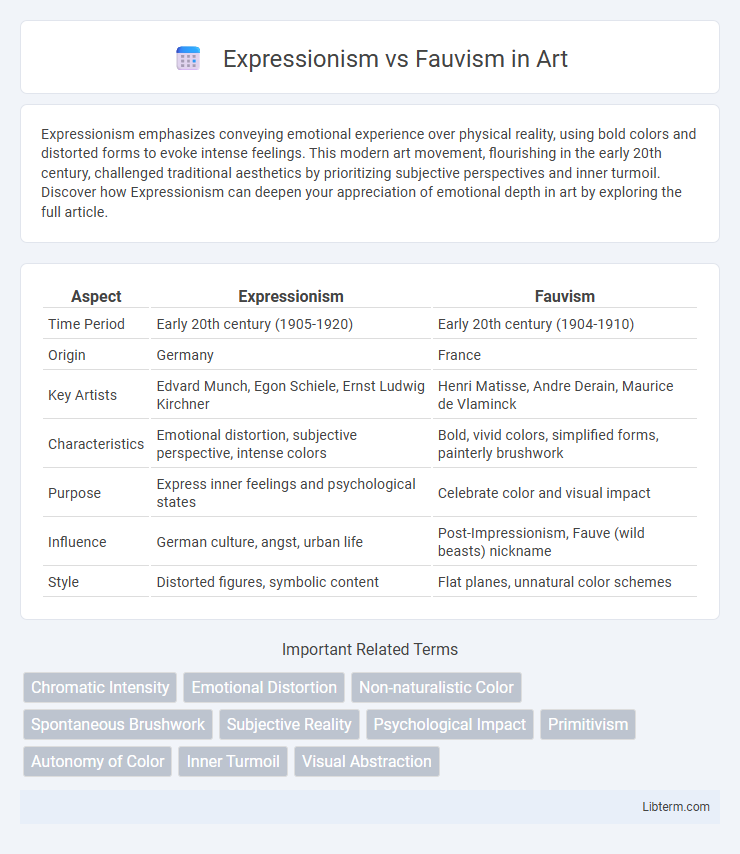Expressionism emphasizes conveying emotional experience over physical reality, using bold colors and distorted forms to evoke intense feelings. This modern art movement, flourishing in the early 20th century, challenged traditional aesthetics by prioritizing subjective perspectives and inner turmoil. Discover how Expressionism can deepen your appreciation of emotional depth in art by exploring the full article.
Table of Comparison
| Aspect | Expressionism | Fauvism |
|---|---|---|
| Time Period | Early 20th century (1905-1920) | Early 20th century (1904-1910) |
| Origin | Germany | France |
| Key Artists | Edvard Munch, Egon Schiele, Ernst Ludwig Kirchner | Henri Matisse, Andre Derain, Maurice de Vlaminck |
| Characteristics | Emotional distortion, subjective perspective, intense colors | Bold, vivid colors, simplified forms, painterly brushwork |
| Purpose | Express inner feelings and psychological states | Celebrate color and visual impact |
| Influence | German culture, angst, urban life | Post-Impressionism, Fauve (wild beasts) nickname |
| Style | Distorted figures, symbolic content | Flat planes, unnatural color schemes |
Introduction to Expressionism and Fauvism
Expressionism emerged in early 20th-century Germany, emphasizing emotional experience over physical reality through distorted forms and bold colors to convey inner feelings. Fauvism, originating in France around 1905, is characterized by vibrant, non-naturalistic colors and simplified forms aimed at evoking a visceral, immediate response. Both movements prioritize subjective perception and experimentation with color and form, marking a departure from traditional representational art.
Historical Background of Expressionism
Expressionism emerged in early 20th-century Germany as a reaction against industrialization and urbanization, emphasizing emotional experience over physical reality. Influenced by movements like Symbolism and Post-Impressionism, artists such as Edvard Munch and Ernst Ludwig Kirchner aimed to convey angst and alienation through distorted forms and vivid colors. This style contrasted with Fauvism, which originated in France and prioritized bold color and simplified forms to evoke aesthetic pleasure rather than psychological depth.
Historical Background of Fauvism
Fauvism emerged in the early 20th century, primarily between 1904 and 1908, as a revolutionary art movement led by artists like Henri Matisse and Andre Derain. It developed in France as a reaction against the subdued palettes of Impressionism, emphasizing bold, vivid colors and simplified forms to convey emotional intensity. Fauvist painters prioritized color as the primary means of expression, diverging from the dark, distorted figures characteristic of Expressionism, highlighting a vibrant, optimistic approach to modern art.
Key Characteristics of Expressionism
Expressionism emphasizes intense emotional experience through distorted forms and vivid, often dark, colors to evoke psychological states. Its key characteristics include exaggerated shapes, bold brushstrokes, and a focus on conveying inner feelings rather than realistic representation. Artists like Edvard Munch and Egon Schiele used Expressionism to explore angst, alienation, and emotional turmoil.
Key Characteristics of Fauvism
Fauvism is characterized by its bold, vibrant use of color and simplified forms that emphasize painterly qualities over realistic representation. Artists like Henri Matisse used non-naturalistic colors to evoke emotional responses, applying paint with loose brushwork and a spontaneous approach. This movement contrasts with Expressionism's focus on conveying inner emotional turmoil through distorted forms and darker, more intense color palettes.
Notable Artists in Expressionism
Expressionism is characterized by intense emotional expression and distortion, with notable artists including Edvard Munch, Egon Schiele, and Ernst Ludwig Kirchner, who emphasized raw psychological depth and vivid colors. Unlike Fauvism, which prioritizes bold, non-naturalistic colors and simple forms as seen in works by Henri Matisse and Andre Derain, Expressionism focuses on conveying inner turmoil and existential angst. The German Die Brucke and Der Blaue Reiter groups played central roles in developing Expressionism, pushing the boundaries of modern art through dynamic compositions and symbolic use of color.
Prominent Fauvist Artists
Prominent Fauvist artists such as Henri Matisse, Andre Derain, and Maurice de Vlaminck revolutionized early 20th-century art with their bold, vibrant colors and simplified forms that emphasized emotional expression over realistic representation. Fauvism's intense color palette and dynamic brushstrokes contrasted sharply with Expressionism's often darker themes and distorted forms aimed at conveying psychological depth. The Fauves' vivid, non-naturalistic use of color became a defining characteristic that set the movement apart within the modern art landscape.
Differences in Techniques and Aesthetics
Expressionism emphasizes emotional intensity through distorted forms and exaggerated brushstrokes, often employing dark, moody color palettes to evoke psychological depth. Fauvism prioritizes vibrant, non-naturalistic colors and bold, simplified shapes, creating a sense of raw, spontaneous energy with less focus on emotional turmoil. The techniques in Expressionism rely on agitated, dramatic lines and textures, whereas Fauvist artists use flat areas of pure color and a more decorative approach to composition.
Impact on Modern Art Movements
Expressionism and Fauvism significantly influenced modern art by challenging traditional representation through bold use of color and emotional intensity. Expressionism's emphasis on subjective experience and psychological depth paved the way for Abstract Expressionism and Neo-Expressionism, emphasizing personal meaning and emotional resonance. Fauvism's vibrant color palettes and simplified forms inspired movements like Cubism and Orphism, encouraging experimentation with abstraction and color theory.
Lasting Influence of Expressionism and Fauvism
Expressionism's lasting influence is evident in its emotional intensity and vivid use of color, which shaped modern art movements such as Abstract Expressionism and influenced literature, theater, and film. Fauvism's impact lies in its pioneering use of bold, non-naturalistic colors and simplified forms that paved the way for developments in Cubism and modern graphic design. Both movements fundamentally transformed visual language by prioritizing subjective experience and artistic freedom over realistic representation.
Expressionism Infographic

 libterm.com
libterm.com